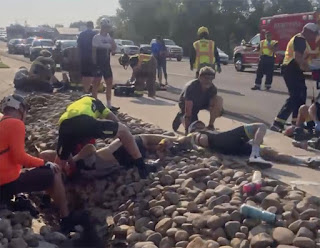Once again, Florida has more cycling fatalities per million residents than any other US state. The Sunshine State has 23.3 million residents, so its rate of 10.4 translates to 242 fatalities per year.
Florida's rate is 11 percent higher than that of second-deadliest Louisiana. New Mexico, South Carolina and Arizona round out the "top" five states for cycling rate fatalities. At the other end of the table, the five "safest" states for cyclists-- Wyoming, Vermont, Alaska, Rhode Island and New Hampshire--all have about the same rate (0.1 per million), or less than one percent of Florida's.
Do you notice some patterns?
The states with the lowest rates are in New England (Vermont, Rhode Island and New Hampshire) or are far-western (or northern) states (Wyoming and Alaska) where outdoor recreation is popular. The deadliest states for cyclists are all car-centric and in the "Sunbelt."
To be fair, none of the "safest" states has a city comparable in size to, say, Miami, Phoenix or even New Orleans. Then again, the New England states have small-to-medium-sized cities with significant populations of college students. Those cities are also older cities , developed before the automobile.
So what, aside from geographical clustering and (to a lesser degree, demographics) do the least dangerous states have share? And what traits do the most perilous states have in common?
 |
| From the website of Christopher G. Burns, Esq. |
According to an article in Legal Reader, the following are among the factors contribute to the relative calm or perilousness of cycling in a particular state:
--Infrastructure Deficiencies. The authors of the article weren't talking about cycling infrastructure. Rather, they refer to wide, high-speed roads that are common in the "deadly" states. Perhaps more important, they also mention planning, in and out of urban areas, that is auto-centric. Thus--as I can attest from my experiences of cycling in Florida and South Carolina--it is all but impossible to go from one place to another without using a "stroad," which often have high-speed lanes connecting them to major highways. Navigating one of those entry and exit points makes crossing Times Square seem like a stroll on a bridge over a theme-park "stream."
--Rural vs. Urban Risk Factors: While urban areas account for 83 percent of total bike fatalities, rural areas actually have higher per-capita rates because of the factors I mentioned my previous paragraph. One reason is that some large cities have at least a skeleton of bike infrastructure and--as I can attest from many years of cycling in New York--lower vehicle speeds make fatalities less likely: A cyclist struck by a car traveling at 40 MPH (65 K/H) has an 85 percent chance of dying, but only 25 percent if the vehicle is going at 20 MPH (32.5 K/H).
--Legal Frameworks: States and other jurisdictions with lower fatality rates also tend to have laws that truly promote cycling safety, such as the Idaho Stop or its variants, and enforce other laws and policies such as those against distracted driving. Also, some of the "safer" states have Vulnerable Road User laws, which impose stricter penalties for motorists who cause harm to cyclists and pedestrians.
In addition to better urban and suburban planning, bicycle infrastructure and better laws (and enforcement), the authors also call for, among other things, mandatory bicycle awareness education in drivers' licensing programs. I think it's a good idea because one difference I notice between cycling in the US (even in "bicycle friendly" places) and Europe is that drivers are more conscious of, and courteous to, cyclists. Some countries have the bicycle awareness training the authors call for, but even in the places that don't, motorists see us differently because many are also cyclists, or were in their recent pasts.






















